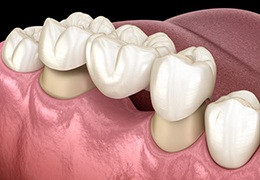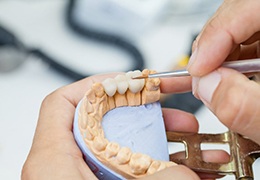Dental Bridges – Goodlettsville, TN
Fill the Empty Space in Your Smile
Every part of the human mouth is interconnected. Because oral anatomy is so delicate, even one missing tooth can result in serious health problems, such as drifting teeth, jawbone deterioration, and an uneven biting force. Not to mention, having a gap in your grin is widely considered unattractive. At Goodlettsville Smiles, Dr. McClain wants you to enjoy the benefits of having a complete smile. One way our team can help you achieve this is by placing a dental bridge. To learn more about dental bridges in Goodlettsville, just give us a call!
Why Choose Goodlettsville Smiles for Dental Bridges?
- Replace Several Consecutive Missing Teeth at Once
- Restorations Custom-Made for Every Patient
- Made of Natural-Looking Dental Porcelain
What Are Dental Bridges?

A traditional bridge, which is the most common variety, consists of two dental crowns that fit over your abutment teeth (the two teeth that are next to the empty space in your smile). One or more artificial teeth, known as pontics, are suspended in between these crowns. This type of restoration can be quite attractive and long-lasting.
You may want to ask Dr. McClain about an implant-retained bridge. Instead of abutment teeth, the pontics are supported by small titanium posts that are surgically inserted into your jawbone. Bridges that are held in place by dental implants generally last longer than traditional bridges.
Is a Dental Bridge Right for Me?

Many patients with one or more missing teeth in a row would make good candidates for a dental bridge. However, you must be in good oral health. If you currently have gum disease or tooth decay, those issues must be addressed prior to bridge placement.
To be eligible for an implant-supported bridge, you must have adequate jawbone density. If your jawbone has shrunk after tooth loss, you must be willing to receive a bone graft so that your body can accommodate implants.
Ultimately, the only way to find out if a dental bridge is right for you is to schedule a consultation with your dentist in Goodlettsville.
The Process of Getting a Dental Bridge

Installing a traditional bridge takes two or more appointments. During the first visit, we remove a small amount of enamel from your abutment teeth to ensure there’s room for the crowns. We then take impressions of the area and send them to a dental lab. While they craft your bridge to our precise specifications, we might place a temporary bridge. Once your final bridge arrives from the lab, we permanently cement it in place.
For an implant-retained bridge, you must undergo oral surgery to have the posts placed, and then wait a few months for them to integrate with your jawbone. This option takes longer, but it provides more stability than a traditional bridge.
Benefits of Dental Bridges

Bridges offer significant advantages to both your health and your appearance. They are able to:
- Prevent remaining teeth from drifting out of place
- Look like a natural part of your smile
- Allow you to chew practically any food
- Last more than 10 years with proper oral hygiene
Dental Bridges FAQs

When it comes to tooth replacement, you should have all the necessary information before you make a decision as which option is right for you. We want you to select the solution that will meet your needs and complete your smile, which is why we happily volunteer to answer any questions you may have about dental bridges. See our responses to common questions below, but don’t hesitate to ask your dentist in Goodlettsville, Dr. Harrison-McClain, during your consultation if you would like to discuss bridges in person.
Are Dental Bridges Comfortable?
To keep you comfortable through the procedure of getting your bridge, we use a local anesthetic before we reduce your abutment teeth, so you won’t feel anything. Once properly in place, your dental bridge should feel a lot like your natural teeth. As long as you keep up your daily maintenance routine and come to our office on a regular basis for checkups and cleanings, you probably won’t even notice the bridge at all after a while.
Does Getting a Dental Bridge Involve Permanently Altering My Teeth?
Yes, in order to make space for a traditional dental bridge, we need to remove a small portion of the enamel on the two teeth immediately surrounding the gap. It’s a lot like preparing a tooth for a dental crown—we just do it twice! On the other hand, if you are receiving an implant bridge, the restoration anchors to dental implants, which means that your healthy teeth’s enamel can remain untouched and preserved for longer.
How Many Teeth Can Be Replaced with a Dental Bridge?
A traditional bridge can be used to replace between one and three consecutive missing teeth, as long as there is one natural tooth on each end of the gap. These abutment teeth are necessary to hold the bridge in place. Implant bridges can address even more missing teeth—between three and five in a row! When Dr. McClain has had the opportunity to examine and evaluate your mouth, she can recommend the treatment best suited to your needs.
Are Dental Bridges Covered by Dental Insurance?
Although some variations can occur from plan to plan, dental insurance generally does cover part of the cost of bridges. Usually, bridges qualify as major restorative care, which applies to about 50 percent of the cost. To help you with your out-of-pocket portion, we can help you apply for low-interest financing through CareCredit. This financier makes it possible to cut your total bill into smaller amounts, so treatment more easily fits in your budget.
